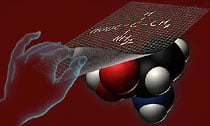Chemistry becomes three-dimensional
| The Nobel Prize in Chemistry 2001 | |
|||||
|
| ||||||
|
van ‘t Hoff (Nobel Prize 1901) was one of the first to realize that molecules are three-dimensional. |
This year’s Nobel Prize has its roots in research carried out by the first Nobel Laureate in Chemistry, J. H. van ‘t Hoff. In 1874 he and J.-A. le Bel proposed the revolutionary hypothesis that molecules are three-dimensional and that they can therefore occur in two forms that are mirror images of each other. Their theory was considered ridiculous, because molecules were thought of as being two-dimensional at that time.
|
|||||
|
||||||
Nobel Prizes and laureates
Six prizes were awarded for achievements that have conferred the greatest benefit to humankind. The 12 laureates' work and discoveries range from proteins' structures and machine learning to fighting for a world free of nuclear weapons.
See them all presented here.


